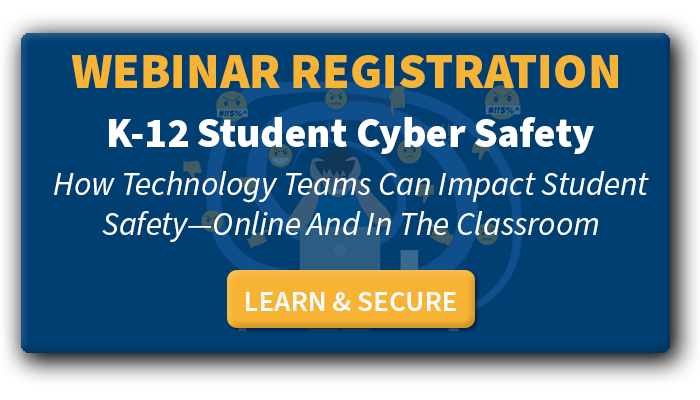Artificial intelligence student cyber safety monitoring helps districts keep students safe online and offline
K-12 district IT teams need all the tools they can find to ensure student cyber safety. It’s important to keep students safe from online risks, and it’s also important for the district to remain compliant with regulatory requirements. Addressing cyber safety in schools requires thinking beyond web content filters since the risks are getting more difficult to spot.
Types of Student Cyber Safety Risks
Many districts are seeing gaps in their ability to spot toxic online behavior. The types of risks to student cyber safety include the following.
1. Cyberbullying
Students are spending more time than ever online due to the remote and hybrid learning that is being used to help fight the COVID-19 pandemic. But, cyberbullying detection can be difficult because it takes so many forms.
There are many opportunities for cyberbullying. Unfortunately, many of those opportunities exist while students are using district-supplied applications. A cyberbully can use apps in Office 365 and Google for Education apps to share negative, false, and embarrassing content about another student.
As a result, students can’t get away from a bully. They can get unwanted contact at home through social media and the harassment can continue in school. The victims of cyberbullying have been shown to develop depression, eating disorders, suicidal tendencies, substance abuse habits, and more. Cyberbullying monitoring is critical since the result isn’t just a bit of teasing—it can be life-altering.
2. Inappropriate and/or Explicit Content
Students can unintentionally end up viewing inappropriate content when they surf the internet. Districts need to be able to block websites that are known to serve this type of content to anyone, even minors. Beyond that, someone who is the target of a cyberbully may receive inappropriate content from the bully.
3. Sexting, Sextortion, and Online Predation
The unhealthy practice of sexting can take place when students share explicit messages or images with one another. This practice can also lead to sextortion when one of the students threatens to share sexting messages or images with others unless the target student shares additional compromising content.
If a hacker is involved in sextortion, they can create a form of ransomware by encrypting the target student’s files and demand sexting in return for releasing the files. This type of online predation can be devastating for a student.
4. Discriminatory and Hate Speech
Ideally, schools are places where students should feel safe and welcome. When discriminatory and hate speech are allowed to flourish, that ideal is lost. School districts can’t allow aggressive speech against students of color, LGBTQ students, or any other minority or target group to be part of any student’s school experience.
5. Threats of Violence
Threats of violence can come from students or cybercriminals. When cybercriminals gain access to a district’s student PII, there are documented cases where the criminals then threatened to release that information. They also contacted parents of students threatening to physically harm the children. This illustrates a strong link between cybersecurity and cyberbullying in K-12 schools.
6. Self-Harm and Suicide
The saddest thing district IT teams need to look out for is indications of self-harm and suicide among the student population. Understanding these two issues is critical. Student self-harm and suicide aren’t the same thing.
Students can act out by hurting themselves, even if they aren’t really planning on suicide. Students sometimes use self-harm to deal with depression and anxiety. Self-harm monitoring must include both text and images.
In today’s digital world, district IT teams are becoming the first line of defense in supporting student suicide prevention. With the right monitoring tools, IT and/or support teams can spot students who may be thinking about suicide. IT can turn that information over to district resources such as teachers and counselors for follow up and resolution.
Student Cyber Safety in District Technology
Students are vulnerable to all of the cyber safety threats when using district technology. They’re using school-provided email, shared documents, shared drives, chat apps, and more. They use this technology to communicate with each other and share images, videos, and text content that could be harmful to themselves and other students. In addition, the district is responsible for CIPA compliance, and any cyber threat on district technology could be a compliance issue.
Students make spotting K-12 cyber safety problems even more complicated because they’re often well-versed in avoiding detection. Students have learned to use white text and unnamed documents. They also might create and delete documents, rename them often, and use other methods to confuse teachers, administrators, and monitoring technology.
Artificial Intelligence in Student Cyber Safety
Artificial Intelligence (AI) is still in its infancy. However, many districts are finding that using AI-powered student cyber safety monitoring tools can help protect students and, in many cases, save lives. It’s a relatively new approach to a “people problem.”
The most important thing to keep in mind is that students need to be educated on social-emotional learning to help them understand and manage emotions. They also need to be taught how to be a good citizen, both online and off.
Monitoring for toxic online behavior, self-harm, and other types of risky behaviors helps keep students safe and helps them learn how to interact with others in positive ways.

![[FREE WEBINAR] Student Cyber Safety in Schools. REGISTER HERE >>](https://no-cache.hubspot.com/cta/default/6834707/5cd0a157-352c-458b-9676-0ad9bb75645a.png)
